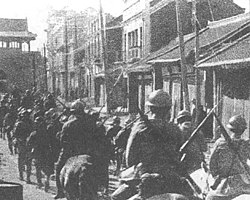1931 Japan false flag railway explosion
|
|---|
- 1931–1937 (pre-war skirmishes)
- 1937–1939
- 1940–1942
- 1943–1945
- Air War
|
The Mukden incident was a false flag event staged by Japanese military personnel as a pretext for the 1931 Japanese invasion of Manchuria.[1][2][3]
On September 18, 1931, Lieutenant Suemori Kawamoto of the Independent Garrison Unit [ja] of the 29th Japanese Infantry Regiment [ja] detonated a small quantity of dynamite[4] close to a railway line owned by Japan's South Manchuria Railway near Mukden (now Shenyang).[5] The explosion was so weak that it failed to destroy the track, and a train passed over it minutes later. The Imperial Japanese Army accused Chinese dissidents of the act and responded with a full invasion that led to the occupation of Manchuria, in which Japan established its puppet state of Manchukuo six months later. The deception was exposed by the Lytton Report of 1932, leading Japan to diplomatic isolation and its March 1933 withdrawal from the League of Nations.[6]
- ^ The Cambridge History of Japan: The Twentieth Century, p. 294, Peter Duus,John Whitney Hall, Cambridge University Press: 1989 ISBN 978-0-521-22357-7
- ^ An instinct for War: Scenes from the battlefields of history, p. 315, Roger J. Spiller, ISBN 978-0-674-01941-6; Harvard University Press
- ^ Concise dictionary of modern Japanese history, p. 120, Janet Hunter, University of California Press: 1984, ISBN 978-0-520-04557-6
- ^ The Cambridge History of Japan: The Twentieth Century, p. 294, Peter Duus, John Whitney Hall, Cambridge University Press: 1989. ISBN 978-0-521-22357-7
- ^ Fenby, Jonathan. Chiang Kai-shek: China's Generalissimo and the Nation He Lost. Carroll & Graf: 2003, p. 202
- ^ Encyclopedia of war crimes and genocide, p. 128, Leslie Alan Horvitz & Christopher Catherwood, Facts on File (2011); ISBN 978-0-8160-8083-0

